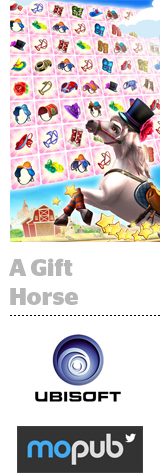 App publishers are constantly walking the line between user experience and making money.
App publishers are constantly walking the line between user experience and making money.
That’s the “main challenge” facing Baptiste Chardon, the man in charge of handling monetization for French game publisher Ubisoft’s more than 25 free-to-play mobile titles, which range from kid games to less casual offerings.
An additional challenge lies in making sure that advertising doesn’t compete against or discourage from in-app purchases (IAP) and vice versa.
Rewarded video is one way for developers to strike that balance because it’s a format that can be used to monetize paying players and nonpaying players alike, Chardon said.
In part, that’s because “it’s not being forced on the user,” he said. “It’s something the user decides to interact with to get something positive in return.”
Ubisoft has been working directly with Twitter’s mobile ad exchange, MoPub, on monetization, including tapping into MoPub’s rewarded video solution, which rolled out in September, with demand coming from ad networks like AdColony, Chartboost, Vungle and Unity Ads.
After hooking up with MoPub, Ubisoft started testing rewarded video on several of its titles, including “Rayman Adventures,” “Smurfs Epic Run” and “Horse Haven World Adventures,” while continuing to monetize its other mobile games with full-screen display and regular video.
In short order, Chardon and his team found that the rewarded format narrowed the revenue gap between its paying users and those who had never made an in-app purchase before.
Players, especially of the nonpaying variety, come in all different flavors. Some have never considered making an in-app purchase, but they would if presented with the opportunity. Others are simply never going to shell out – but they’re still monetizable.
Ubisoft used rewarded video to give the first category of nonpayers – those who aren’t necessarily opposed to spending money in a game but haven’t yet done so – a free taste of the game’s economy and a sense of what it would be like to be a paying player with access to more premium content.
For the unrepentant nonpayers, the opportunity to watch videos in return for virtual goods kept them engaged with the game for a longer period of time, which meant they ended up seeing ads and generating more revenue for Ubisoft.
Ubisoft saw the average lifetime value (LTV) of its users double after rolling out rewarded video, and has since expanded the format to 19 of its titles.
It’s clear why rewarded video appeals to publishers and why users are open to engaging with the format, but there is a question as to how effective an incentivized ad can be from the advertiser’s perspective.
According to Elain Szu, senior manager of exchange marketing at Twitter/MoPub, rewarded video allows advertisers to get more bang for their buck.
“Advertisers can run the exact same video campaign that they already have ready to go, but achieve essentially a guaranteed completion rate,” Szu said. “It’s anecdotal, but we’ve heard consistently that completion rates for rewarded video are 99% or above from many demand partners.”
In theory, that gives advertisers a larger share of the user’s attention.
“Rewarded video ads provide users with an additional reason to watch the whole video, giving the advertiser more leeway and time to get their message across for their brand than a video that you can skip after a few seconds,” she said.
But rewarded video isn’t a universal panacea. Rather, it’s just one ingredient in a healthy monetization mix that can and should change depending on the game and user behavior, especially when a studio has a portfolio of games as diverse as Ubisoft does.
“It’s pretty hard to have a universal strategy,” said Chardon.
Although some best practices are widely accepted and applied – like it’s a bad idea to hammer an engaged user with distracting advertising while they’re in the midst of gameplay, for example – optimizing LTV is nuanced mix of art and science.
“Finding the perfect mix of monetization options means you have to balance user metrics and monetization methods and test frequently,” Szu said. “Just as every user is different, every game is different. While not all your users might be into in-app purchases, they might be persuaded to if they receive some gems or jetpacks after they get one in exchange for watching a rewarded video.”













